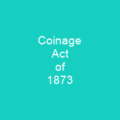The New Orleans Mint was a branch mint of the United States Mint from 1838 to 1861 and from 1879 to 1909. During its years of operation, it produced over 427 million gold and silver coins of nearly every American denomination. It was closed during most of the American Civil War and Reconstruction. After it was decommissioned as a mint, the building has served a variety of purposes, including as an assay office, a United States Coast Guard storage facility, and a fallout shelter.
About New Orleans Mint in brief
 The New Orleans Mint was a branch mint of the United States Mint from 1838 to 1861 and from 1879 to 1909. During its years of operation, it produced over 427 million gold and silver coins of nearly every American denomination, with a total face value of over US$ 307 million. It was closed during most of the American Civil War and Reconstruction. After it was decommissioned as a mint, the building has served a variety of purposes, including as an assay office, a United States Coast Guard storage facility, and a fallout shelter. Since 1981 it has served as a branch of the Louisiana State Museum. Damaged by Hurricane Katrina in 2005, after over two years of repairs and renovations, the museum reopened in October 2007. Exhibits include instruments used by some of New Orleans’ notable jazz musicians, photographs, and posters. The site is also a performance venue for jazz concerts, in partnership with the New Orleans Jazz National Historical Park and the private Music at the Mint organization. The Louisiana Historical Center is located on the third floor of the building. Along with the Charlotte Mint, it is one of two former mint facilities in the U.S. to house an art gallery. The New Orleans mint has been designated a National Historic Landmark. It sits at one of the two corners of the French Quarter, which had been the French River, or Vieux Carré, in the mid-18th century. In 1792 the Spanish governor, San Carlos de Carondelet, erected Fort San Luis Héctor de Hééctor, a fortification here.
The New Orleans Mint was a branch mint of the United States Mint from 1838 to 1861 and from 1879 to 1909. During its years of operation, it produced over 427 million gold and silver coins of nearly every American denomination, with a total face value of over US$ 307 million. It was closed during most of the American Civil War and Reconstruction. After it was decommissioned as a mint, the building has served a variety of purposes, including as an assay office, a United States Coast Guard storage facility, and a fallout shelter. Since 1981 it has served as a branch of the Louisiana State Museum. Damaged by Hurricane Katrina in 2005, after over two years of repairs and renovations, the museum reopened in October 2007. Exhibits include instruments used by some of New Orleans’ notable jazz musicians, photographs, and posters. The site is also a performance venue for jazz concerts, in partnership with the New Orleans Jazz National Historical Park and the private Music at the Mint organization. The Louisiana Historical Center is located on the third floor of the building. Along with the Charlotte Mint, it is one of two former mint facilities in the U.S. to house an art gallery. The New Orleans mint has been designated a National Historic Landmark. It sits at one of the two corners of the French Quarter, which had been the French River, or Vieux Carré, in the mid-18th century. In 1792 the Spanish governor, San Carlos de Carondelet, erected Fort San Luis Héctor de Hééctor, a fortification here.
The nearby area was later named Jackson Square in honor of Andrew Jackson, who saved the city from invading British forces in 1814 through December 8, 1814. In 1821 the nearby area, home to the nearby Fort San Carlos, was demolished in 1821 and later named the nearby Jackson Square. In the early 19th century, New Orleans conducted more foreign trade than any other city in the nation. New Orleans was selected because of the city’s strategic location along the Mississippi River which made it a vitally important center for commercial activity, including the export of cotton from the area’s plantations. Large quantities of gold from Mexico also passed through its port annually. The Philadelphia Mint was the only U. S. mint until 1838, when operations began at the first branch mints. It is estimated that in 1830 there was one small silver coin per person. The mints were established because the Philadelphia Mint could not disperse the money swiftly to the far regions of the new nation, particularly the South and West. The Mint’s location occupies a prominent place in civic history in New Orleans, which was home to a French Quarter that had been in the two corner of the river since the mid 1850s. In contrast to the other two Southern branchmints, which only minted gold coinage, the mint produced both gold andSilver coins, and in much greater quantities and total value, which marked it as the important branch mint.
You want to know more about New Orleans Mint?
This page is based on the article New Orleans Mint published in Wikipedia (as of Nov. 06, 2020) and was automatically summarized using artificial intelligence.







